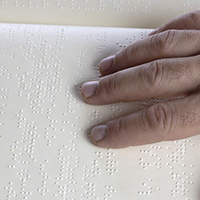 |
This year, we mark World Braille Day by sharing a story written for us by local student Tilly, who is a PhD student in the Department of History at the University of Sheffield. She researches nineteenth-century tactile alphabets and correspondence networks in the British blind community.
Thank you Tilly, this is a very interesting read.
|
World Braille Day: Sheffield’s place in the ‘Battle of the Types’
This World Braille Day we continue to celebrate 200 years since Louis Braille developed and perfected his writing system between 1821 and 1837. This anniversary does not, however, align with the adoption of Braille in the UK, which was a fitful process lasting half a century.
In the intervening years, Britain was host to a ‘Battle of the Types’, as a series of inventors thought they could do better than the French boy’s code of dots, and created tactile reading systems of their own.
As late as 1871, five different scripts were still being taught and printed in the UK, which meant that blind communities in different regions were taught to read different alphabets. As a result, they could not easily share books or write to one another.
The great debate was divided between scripts which resembled the printed Roman alphabet, and those based on an ‘arbitrary’ code, such as Braille. Many sighted educators favoured the former, as they could teach blind students to read without having to learn a new alphabet themselves, and argued that it would promote better integration with the sighted world. Blind readers on the other hand noted that scripts based on shapes designed for the fingertips were more accessible.
In 1847, a bridge of sorts was forged between these two camps, as the blind William Moon designed a script based on the Roman alphabet, but formed of simple tactile shapes. It was an immediate success with charitable organisations teaching blind people to read in their homes, as it suited an older generation with less tactile sensitivity or more familiarity with the appearance of printed text. Moon was significant because it asserted the needs of the blind reader. Arguably this was something of a gateway to the acceptance of codes like Braille, making them palatable to sighted educators in a way that they were not back in the 1820s.
Though not a smooth trajectory, this ultimately led to the creation in 1868 of a committee of blind men determined to decide the best script for their fellow touch readers. This group - the British and Foreign Blind Association (BFBA – later to become the RNIB) - settled on Braille two years later, but Moon continued to be acknowledged for its particular advantages. Meanwhile in Sheffield, the School for the Mental and Industrial Training of the Young Blind opened later that decade in 1879. It was thus perfectly positioned to reap the rewards of 60 years of trial and error in the world of tactile alphabets. The decision was made to teach both Braille and Moon to the new students.
By 1905, reading and writing were still a priority at the Sheffield school; a sample timetable featured at the International Conference on the Blind in Edinburgh showed lessons in reading, writing, or arithmetic every morning. Although shortages of embossed books remained a problem due to the expense of their production, the channelling of efforts towards Braille on a national scale allowed for more rapid improvement of technology. A faster method of embossed printing was invented by a Mr Maclaren of Edinburgh, for example, which was warmly received at the Edinburgh conference. Advancing typewriter technology also allowed for the proliferation of mechanical Braille writing, after the invention of the Hall Braille-writer in the US in 1892. Consequently, Henry Stainsby of the Birmingham blind institution was able to comment in 1905: ‘the prospects of blind typists are better today than I have ever known them before’. By the turn of the twentieth century, then, Braille had finally been recognised as the powerful tool that it is. The long-fought battle for its implementation reminds us that World Braille Day is really something to be celebrated.
Bibliography:
Report of the International Conference on the Blind and Exhibition, held at the Central Halls, Edinburgh (June 1905, Glasgow and Edinburgh), pp. 60, 70, 76-77, 90
Frost, Richard, ‘Sheffield Royal Society for the Blind: At the heart of the community for 160 years’ Sheffield Royal Society for the Blind (2023)
Oliphant, John, ‘”Touching the Light”: the invention of literacy for the blind’, Paedagogica Historica 44/1-2 (2008)
Peach, Jane, ‘Our History in Sheffield 1860-2020’, Sheffield Royal Society for the Blind (2021)
Tilley, Heather, Blindness and Writing: from Wordsworth to Gissing (Cambridge, 2018)
Tilly Guthrie is a PhD student in the Department of History at the University of Sheffield. She researches nineteenth-century tactile alphabets and correspondence networks in the British blind community.